Observatorio Astronómico Nacional
Infraestructura científica con más de 200 años

Proyectos de investigación
DENSEGAS
Proyecto PID2019-108765GB-I00. Evolución del gas denso interestelar y su papel como vínculo entre la formación estelar galáctica y extra galáctica.
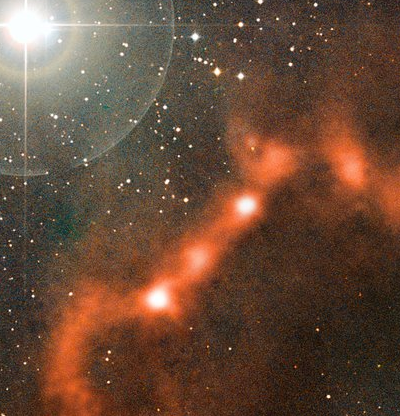
La formación estelar es una de las últimas fronteras de la astrofísica moderna. Resulta de una mezcla compleja de gravedad, turbulencia, campos magnéticos y feedback. Estas interacciones actúan a diferentes escalas espaciales, y su estudio requiere combinar observaciones galácticas y extragalácticas. A escalas galácticas, seguiremos la secuencia de fragmentación responsable de la formación estelar. Esta secuencia comienza con la formación de filamentos a escalas multi-pc. Estos filamentos se fragmentan en estructuras menores llamadas fibras, que son las auténticas predecesoras de las condensaciones densas y las protoestrellas. Para estudiar la naturaleza de estas fibras, usaremos datos tomados con el interferómetro ALMA y determinaremos su estructura interna y cinemática. El estudio de la fragmentación continuará con la formación de condensaciones densas, de las que se estudiará su conexión con las fibras y su posterior fragmentación en sistemas estelares. A escalas extragalácticas, cartografiaremos con ALMA la emisión del gas denso en galaxias vecinas complementando las observaciones del proyecto PHANGS. Además, estudiaremos la excitación del gas denso para cuantificar cómo la emisión molecular refleja la masa de gas denso a lo largo de los discos galácticos. Estos dos proyectos permitirán poner a prueba las distintas teorías de formación estelar usando observaciones extragalácticas. Agradecemos el apoyo del proyecto PID2019-108765GB-I00, financiado por MCIN/AEI/10.13039/501100011033.

PHYSCHEM
Proyecto PID2019-106235GB-I00. Evolución física y química durante la formación de estrellas y planetas
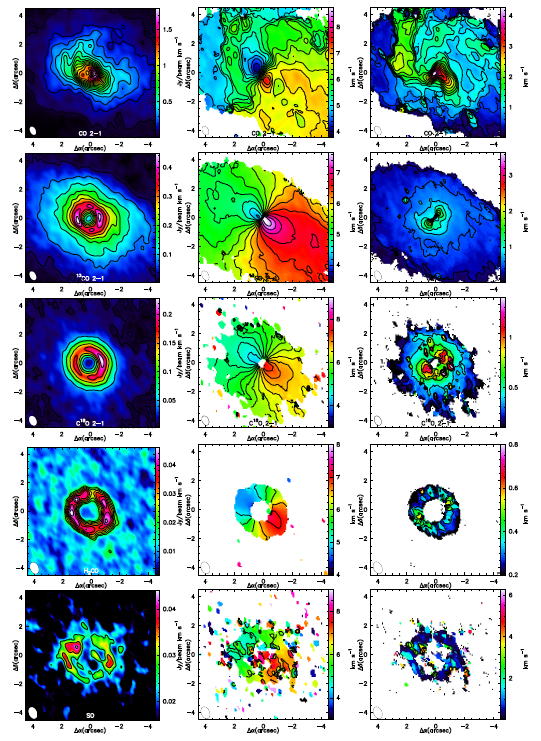
El objetivo de este proyecto es el estudio de la evolución química y dinámica que siguen el gas y el polvo desde las primeras fases en la nube materna hasta la formación de un disco proto-planetario. Cartografías a gran escala de las nubes moleculares utilizando conocidos trazadores moleculares son necesarias para determinar las condiciones físicas, la dinámica y la composición química de las nubes natales. Observaciones con gran resolución espacial del polvo y del gas utilizando grandes interferómetros se requieren para investigar la estructura física y composición química de las condensaciones pre-estelares, las proto-estrellas y los discos proto-planetarios. El análisis detallado de estos datos y la posterior modelización de la emisión del gas y el polvo utilizando sofisticados modelos químicos que incluyen reacciones en fase gaseosa y en la superficie de los granos, simulaciones magnetohidrodinámicas 3D y códigos de transferencia radiativa, nos permite determinar la estructura física y composición química detallada de estos objetos. Agradecemos el apoyo del proyecto PID2019-106235GB-I00, financiado por MCIU/AEI/10.13039/501100011033.

CRISPNESS
Proyecto PID2023-146056NB-C21. Envolturas circunestelares AGB y post-AGB: El papel de la compañera en la formación de nebulosas en estrellas evolucionadas
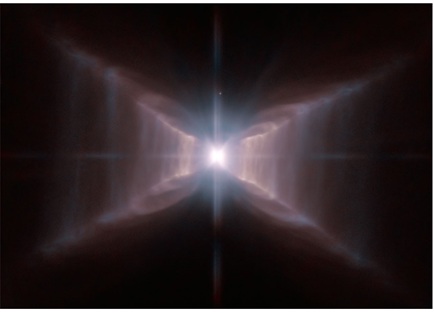
El proyecto de I+D+i CRISPNESS (OAN/IGN, gestionado por el CNIG), tiene como objetivo estudiar la evolución tardía de estrellas de masa baja e intermedia, las más abundantes en la galaxia, enfocándose en las intensas pérdidas de masa que sufren durante la fase AGB. Estas pérdidas de masa generan unas envolturas circunestelares (CSEs), normalmente esféricas, que posteriormente dan lugar a pre-nebulosas y nebulosas planetarias (pPNe y PNe). Sin embargo, la mayoría de estas nebulosas no presentan simetría esférica, lo que sugiere la influencia de estrellas compañeras que, al formar discos de acrecimiento, generan vientos bipolares capaces de deformar la envoltura AGB. Aunque este paradigma está bastante aceptado, existen aún numerosas incógnitas: no se identifican suficientes binarias en las fases previas, ni se detecta toda la masa perdida en la fase AGB, ni se comprende bien el tipo de interacción que produce las complejas estructuras observadas. Este proyecto pretende resolver algunas de estas dudas, mejorando el conocimiento estadístico sobre sistemas binarios en las fases AGB, pPN y PN, estudiando envolturas sospechosas de albergar sistemas binarios, analizando pPNe con distintos momentos lineales, y observando objetos icónicos. Se utilizarán diversas técnicas observacionales, tanto en ondas radio como en otras longitudes de onda, nuevos trazadores y herramientas mejoradas de modelización, poniendo especial énfasis en la caracterización de jets y discos rotantes. CRISPNESS está coordinado con el proyecto INSIGHTS (CAB, INTA/CSIC) formando la "Madrid Evolved Star Outflows Network (MESÓN)". CRISPNESS, ayuda PID2023-146056NB-C21, está financiado por MICIU/AEI/10.13039/501100011033 y por FEDER/UE.

EVENTs
Proyecto PID2019-105203BG-C21. Pérdida de masa, envolturas circunestelares, y el rol de las binarias en estrellas evolucionadas

El objetivo de este proyecto es conocer el mecanismo de pérdida de masa y las propiedades de las envolturas y nebulosas resultantes en las últimas etapas de la evolución de las estrellas de masa intermedia. Se centra en tres aspectos principales: a) caracterizar las propiedades de las estructuras circumestelares, los vientos de las estrellas AGB y post-AGB, especialmente sus capas más internas donde se origina la asimetría en la fase AGB y la colimación de los chorros pAGB ; b) sondear y caracterizar directamente la rápida pérdida de masa pAGB bipolar y los chorros, mediante la emisión en continuo libre-libre y RRL, así como con espectroscopía óptica; c) vincular las propiedades de los vientos y chorros a la presencia de sistemas binarios directa o indirectamente, mediante la detección del compañero compacto o su disco de acreción, y su atracción gravitacional en el AGB / pAGB primario o en el viento del objeto primario. El proyecto EVENTs forma parte del proyecto de investiagación coordinado NEBULAE WEB (eNvelopes and nEBULae of Agb stars and bEyond: Winds, jEts and Binaries).El proyecto de investigación EVENTS, beca PID2019-105203BG-C21, está financiado por el MICIU/AEI/10.13039/501100011033.

XGALGAS
Proyecto PID2022-138560NB-I00. Una visión multi-escala/multi-longitud de onda del ciclo del gas en las galaxias
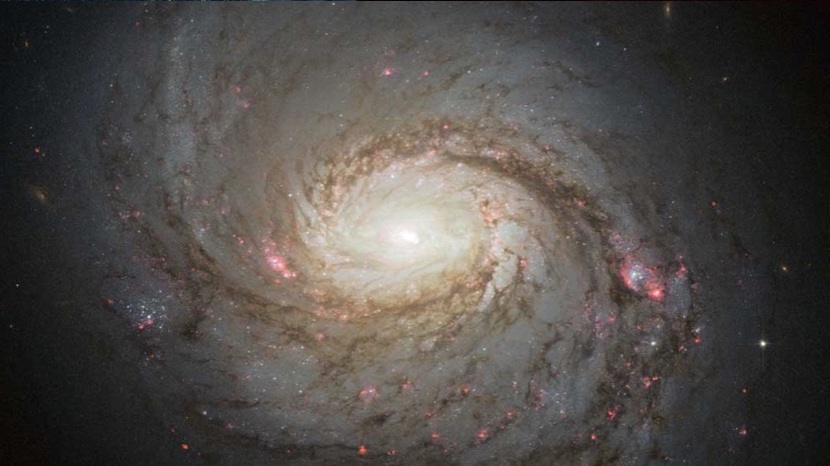
El estudio del gas molecular es clave para comprender la formación y evolución de las galaxias en el Universo. Este proyecto de investigación pretende profundizar en nuestro conocimiento de los procesos físicos que regulan el ciclo del gas y la evolución de las galaxias en un amplio rango de escalas espaciales utilizando observaciones de alta resolución con instrumentación astronómica de primer nivel. Estas observaciones incluyen ALMA, NOEMA, telescopio de 30 m de IRAM y el telescopio espacial JWST, entre otros. En particular, se busca profundizar en la comprensión del fenómeno de núcleos activos, formación estelar y el papel del entorno. Agradecemos el apoyo del proyecto PID2022-138560NB-I00, financiado por MICIU/AEI/10.13039/501100011033 y por FEDER, UE.

AGN-EHE-II-4
Proyecto PID2019-106027GA-C44. La perspectiva de ALMA sobre el ciclo de gas en galaxias activas
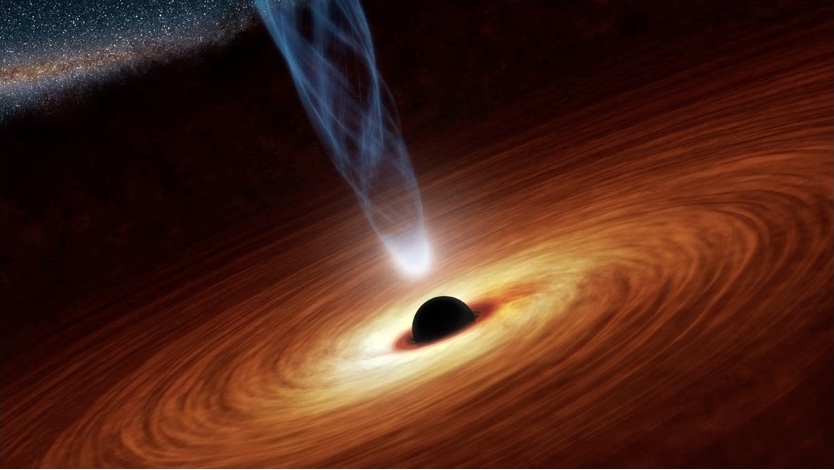
El proyecto coordinado AGN-EHE-II-4 busca profundizar en la comprensión del fenómeno de los núcleos galácticos activos (AGN) y su impacto sobre la evolución de las galaxias. Involucra equipos del OAN, IAA, IAC y UB, que se complementan desde una perspectiva observacional y teórica. El subproyecto “La perspectiva de ALMA sobre el ciclo de gas en galaxias activas” del OAN tiene como objetivo aproximarse al fenómeno AGN desde el punto de vista del gas molecular. Tenemos acceso privilegiado a un conjunto de observaciones a través de PHANGS, un programa extenso de ALMA, y de los consorcios NUGA-ALMA y GATOS-ALMA. Utilizaremos esas observaciones únicas para estudiar cómo los AGNs afectan las propiedades del gas molecular en la galaxia anfitriona y la capacidad del gas de formar estrellas. Agradecemos el apoyo del proyecto PID2019-106027GA-C44, financiado por MCIN/AEI/10.13039/501100011033.

AxiN
El surgimiento de la simetría axial en nebulosas de estrellas evolucionadas

Con el proyecto Axin se pretende avanzar en nuestro entendimiento de cómo objetos tan sencillos y simétricamente esféricos como nuestro Sol, son capaces de dar lugar a las complicadas estructuras que se observan en las nebulosas planetarias que forman al final de sus vidas. En particular estamos interesados en esclarecer el papel que desempeña la presencia de estrellas compañeras en la formación de las estructuras axiales que con frecuencia se observan en las nebulosas planetarias.
SFERA
Formación estelar en múltiples escalas espaciales en la época de ALMA
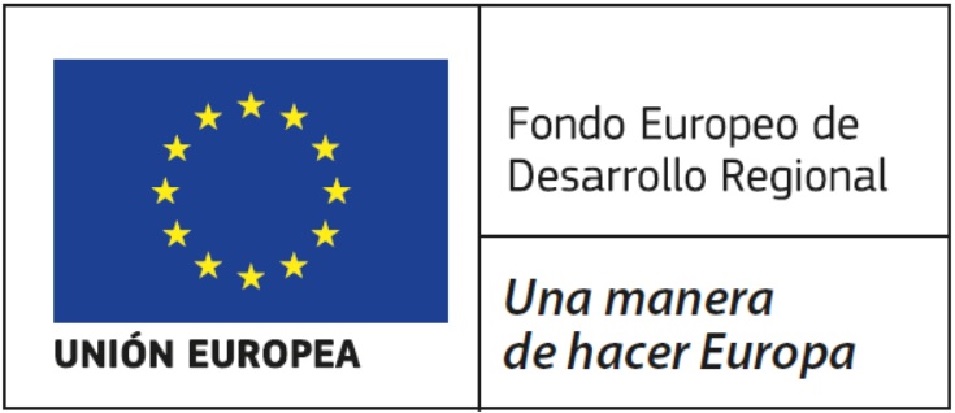
El proyecto SFERA tiene como objetivo explorar algunos de los problemas en formación estelar que involucran múltiples escalas espaciales y que no han podido ser abordados hasta ahora por limitaciones técnicas. Combinando el uso de antenas únicas, como los telescopios IRAM 30m y Yebes 40m, con el uso del recientemente inaugurado interferómetro ALMA esperamos avanzar en el estudio de los flujos bipolares producidos por protoestrellas, la fragmentación y formación de filamentos/fibras en nubes moleculares, y el papel del gas denso en la formación estelar a escalas galácticas. Proyecto AYA2016-79006-P financiado por MCIN/AEI/10.13039/501100011033/ y por FEDER, “Una manera de hacer Europa”.
EMPIRE
Estudio Multilínea con EMIR de la Regulación de la Evolución Galáctica por el Medio Interestelar
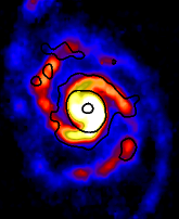
EMPIRE es el primer estudio de gran campo de multiples líneas de emisión centrado en el medio molecular denso de 9 galaxias cercanas con formación estelar moderada. Las observaciones de gran sensibilidad obtenidas por EMPIRE con el telescopio de 30 metros de IRAM permitirán: (1) determinar la distribución de densidades del gas y explorar su relación con el entorno dentro de cada galaxia; (2) establecer cómo depende la eficiencia de formación estelar del gas de la distribución de densidades, dentro de cada galaxia y entre los objetos de la muestra.
GATOS
Galactic Activity, Torus and Outflow Survey
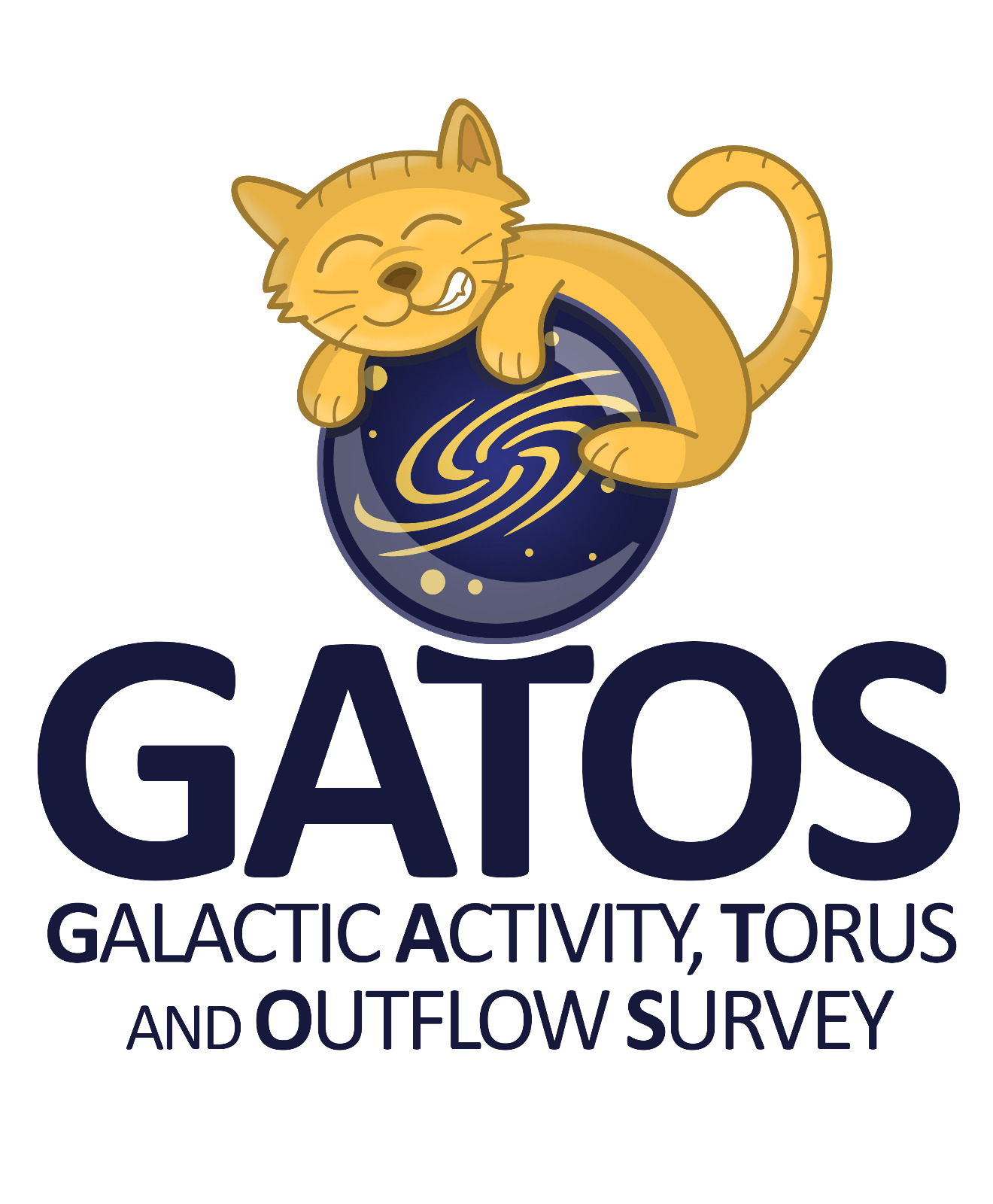
El proyecto GATOS reúne a un equipo multidisciplinar de astrónomos que investigan los procesos físicos que tienen lugar en los núcleos de las galaxias activas. Este proyecto usa información procedente de observaciones en longitudes de onda milimétricas realizadas con el interferómetro ALMA, observaciones ópticas con GTC y VLT, así como instrumentación infrarroja que estará disponible en un futuro próximo con JSWT (2021).
Consultar equipo del proyecto.
NUGA
NUclei of Galaxies
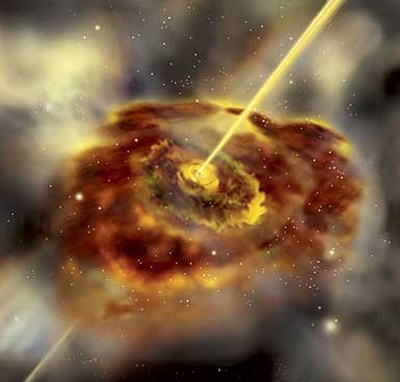
El proyecto NUGA estudia los mecanismos de transferencia de momento angular del gas en los discos de una muestra de galaxias activas del universo local. Este proyecto usa observaciones de alta resolución espacial realizadas con interferómetros como NOEMA y ALMA, que operan en le rango de longitudes de onda milimétricas.
Consultar equipo del proyecto.
PHANGS
Física del Gas y de la Formación Estelar en Galaxias Cercanas
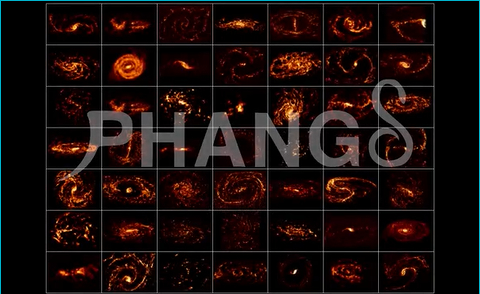
PHANGS es una gran colaboración cuyo propósito es comprender la relación entre la física del gas y la formación estelar en pequeñas escalas con la estructura y la evolución de las galaxias. Combinando nuevos instrumentos que operan en el rango de ondas milimétricas (ALMA, IRAM NOEMA) y en el visible (VLT/MUSE) con observaciones en otras longitudes de onda, PHANGS pretende acumular una extensa base de datos de observación con la que afrontar algunas cuestiones fundamentales sobre la población de galaxias cercanas. Ver video del proyecto.
PHIBSS2
IRAM Plateau de Bure High-z Blue Sequence Survey
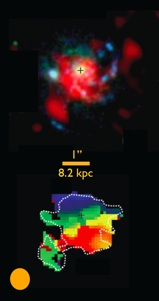
PHIBSS2 es un proyecto de legado realizado con el interferómetro NOEMA, que investiga la evolución de las galaxias en el Universo joven. Estas observaciones exploran el contenido y la cinemática del gas molecular en una muestra de galaxias situadas en la secuencia principal ("Main Sequence") entorno a una época en la que la formación estelar alcanza su máximo valor a lo largo la historia del universo
Consultar equipo del proyecto.
VERTICO
The Virgo Environment Traced in CO Survey
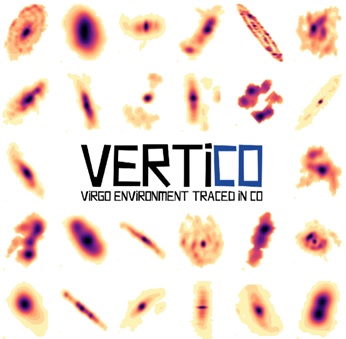
VERTICO es un ¨Large Program¨ en curso de ALMA, que revela los efectos del entorno galáctico en la evolución de las galaxias. Estas observaciones, realizadas en 51 galaxias del cúmulo de Virgo proporcionan un detalle sin precedentes del gas molecular, el combustible principal para la formación de estrellas. VERTICO tiene como objetivo avanzar en cuestiones clave sobre cómo el entorno impulsa la evolución de las galaxias y comprender el modo dominante de influencia en las galaxias.
TIMER
Time Inference with Muse in Extragalactic Rings

TIMER es un programa de investigación llevado a cabo por un equipo internacional de expertos con el objetivo de establecer el momento preciso del tiempo cósmico en que los discos galácticos se vuelven dinámicamente maduros. Los discos alcanzan este estado cuando tienen un soporte dinámico por la rotación diferencial y cuando la fuerza de gravedad es importante. Para este estudio, estamos haciendo uso de observaciones de VLT/MUSE de 21 galaxias barradas masivas y cercanas.
SKA
The Cradle of life
El SKA tomará imágenes de la emisión térmica del polvo en la zona habitable de discos protoplanetarios con un detalle sin precedentes. En particular, mostrará dónde evoluciona el polvo de partículas interestelares desde tamaños de una micra a "guijarros" de un centímetro, el primer paso en el ensamblaje de planetas similares a la Tierra. Los proto-planetas gigantes pueden abrir espacios casi vacíos en el material de los discos, revelando su presencia, así como impulsar ondas espirales a gran escala a través del mismo. Debido a que los tiempos orbitales en el disco interno son cortos, solo unos pocos años, estas observaciones realizadas a lo largo del tiempo pueden rastrear la evolución de estas características para discernir el mecanismo de formación de diferentes tipos de planetas.
ORION-4D
Hacia una teoría unificada de la formación de estrellas de alta y baja masa.

El estudio ORION-4D tiene como objetivo investigar las propiedades dinámicas, físicas y químicas del gas en los filamentos de Orión A. Este proyecto combina un nuevo conjunto de observaciones de antena única, de última generación (IRAM30m, EFF100m y APEX12m) e interferométricas (ALMA) durante más de 400 horas de tiempo de telescopio.
El estudio ORION-4D producirá un conjunto único de observaciones de líneas moleculares de alta sensibilidad y gran escala de toda la nube de Orión A. Su amplia cobertura espectral incluye observaciones de 30 especies moleculares (por ejemplo, C18O, HCN, N2H +, NH3, etc.), sensibles a diferentes propiedades físicas y dinámicas del gas (densidad, temperatura, densidad de columna, composición química o estructura de velocidades). La calidad, resolución y extensión sin precedentes de los datos de ORION-4D permitirán analizar simultáneamente las propiedades cinemáticas (2 + 1D) y químicas (+ 1D) del gas a gran escala dentro de esta enorme nube molecular.
CHEX-MATE
The Cluster HEritage project with XMM-Newton - Mass Assembly and Thermodynamics at the Endpoint of structure formation
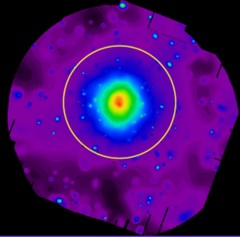
CHEX-MATE es un programa Heritage de tres mega-segundos para obtener observaciones en rayos X de una muestra de 118 cúmulos de galaxias detectados por Planck a través del efecto Sunyaev-Zel'dovich. El programa tiene como objetivo estudiar los productos finales de la formación de estructuras en términos de tiempo y masa. Se compone de un conjunto de los objetos que se han formado más recientemente, junto con una muestra de los objetos de mayor masa del Universo. El programa (1) proporcionará una visión precisa de las propiedades estadísticas de la población subyacente, (2) medirá cómo se forma el gas por colapso en el halo de materia oscura, (3) descubrirá la procedencia del calentamiento no gravitacional y (4) resolverá las principales incertidumbres en la determinación de la masa que limitan el uso de los cúmulos para la estimación de parámetros cosmológicos.
DEGAS
The Dense Extragalactic GBT+Argus Survey

Casi todas las teorías sobre la formación estelar muestran la densidad del gas como una variable clave. Del mismo modo, las observaciones en la Vía Láctea y las galaxias cercanas sugieren un vínculo estrecho entre el gas denso y la formación de estrellas. Las primeras observaciones de galaxias cercanas sugirieron una relación simple entre la cantidad de gas denso y la cantidad de formación de estrellas en una galaxia. Sin embargo, estudios recientes de gas molecular denso resuelto en galaxias cercanas han demostrado que la fracción de gas denso y la eficiencia de formación estelar varían dentro de las galaxias individuales y entre galaxias diferentes. Debido a la baja intensidad de los trazadores primarios de gas denso (HCN y HCO+) estos estudios se han limitado a muestras pequeñas (5-10) de galaxias normales. El programa DEGAS, por tanto, tiene como objetivo mapear el gas molecular denso en los 2arcmin centrales de 36 galaxias cercanas a una resolución moderada (10arcsec). Una vez completo, DEGAS será el estudio más grande de gas molecular denso hasta la fecha.
INSPIRING
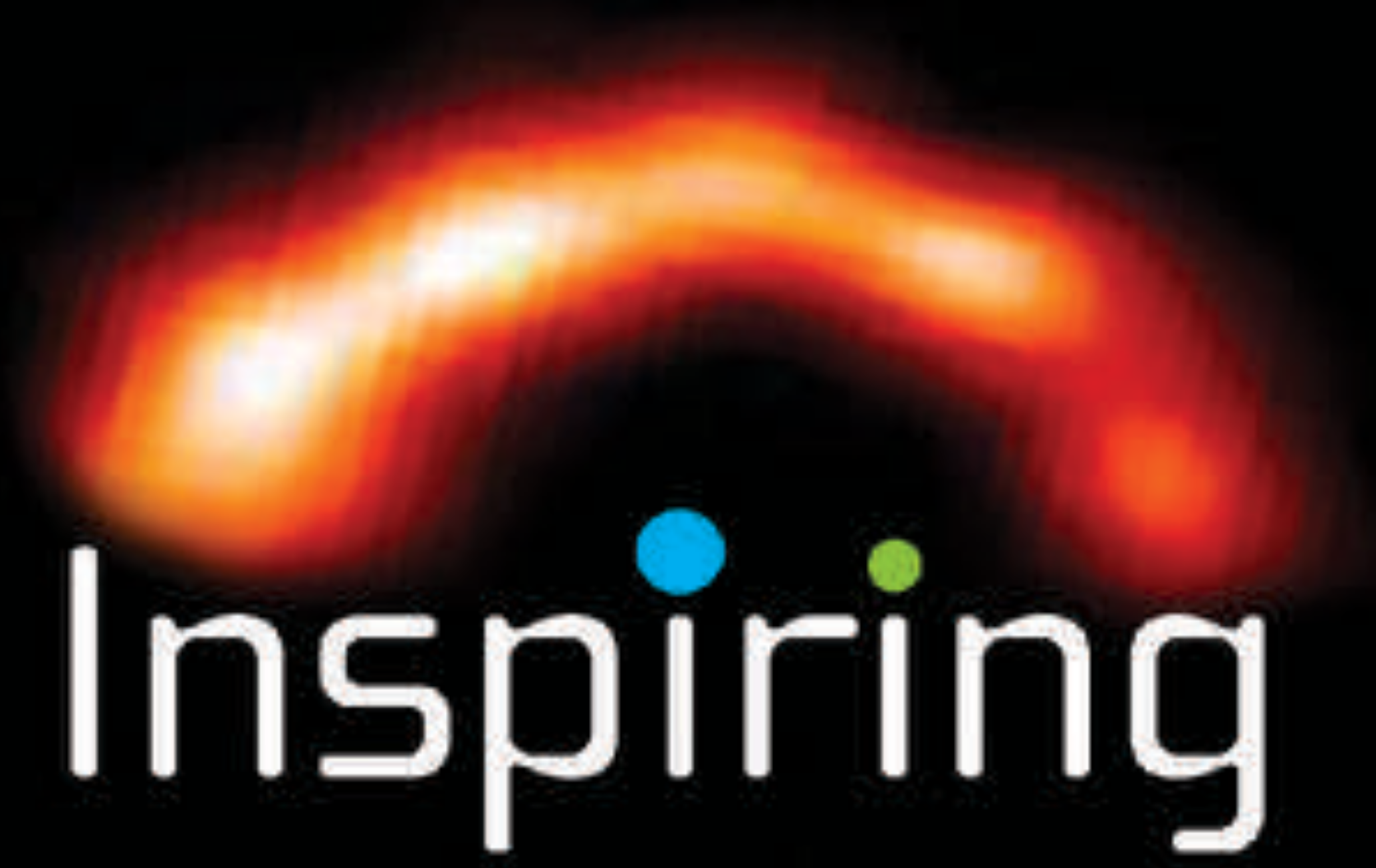
INSPIRING es un ¨Large Program¨ del VLTI para obtener imágenes de discos circumbinarios alrededor de estrellas evolucionadas, e investigar la evolución estelar binaria a través del estudio de post-AGB binarios. La técnica interferométrica del infrarrojo cercano ofrece la oportunidad de resolver los primeras piezas de la formación de estos sistemas (el borde interno del disco circumbinario, o los signos de acreción) de las fuentes seleccionadas, con una complejidad morfológica que los modelos geométricos no son capaces de reproducir. Utilizando imágenes del continuo de VLTI de 11 objetos: 1) revelaremos la morfología 3-D del borde interno del disco y restringiremos las interacciones disco / objetos binarios, 2) obtendremos las distancias absolutas, luminosidades y masas de los sistemas, 3) buscaremos evidencia de acreción del disco circumbinario, 4) confirmaremos la presencia de un disco de acreción secundario en toda la muestra, 5) estudiaremos el origen de la componente de flujo extendido y 6) revelaremos una secuencia evolutiva del disco. La combinación de nuevos avances en técnicas de síntesis de apertura con modelos de transferencia radiativa tridimensionales de última generación, nos dará una visión clara de la estructura y evolución de estos discos protoplanetarios de segunda generación.
CONquest
CONquest es un programa en curso de ALMA para encontrar los núcleos de galaxias más oscurecidos en el Universo local (D <300 Mpc para ULIRGs, D <75 Mpc para LIRGs y 10
NOEMA3D
NOEMA3D es un estudio de NOEMA que tiene como objetivo obtener un censo completo de la distribución molecular del gas y la cinemática de galaxias masivas con formación estelar de la secuencia principal, durante el pico y la posterior disminución de la actividad de formación estelar. Para ese propósito, NOEMA3D está realizando observaciones interferométricas resueltas espacialmente de la distribución y la cinemática del medio interestelar molecular en una muestra bien caracterizada de ~ 50-60 galaxias masivas, alrededor del máximo de crecimiento de galaxias a z ~ 0.5-2.0, y más tarde. NOEMA3D abordará una amplia gama de temas sobre el ciclo bariónico, la formación de estrellas, la retroalimentación y la extinción, que son los ejes de la evolución cósmica de las galaxias con formación estelar.
ALCHEMI
The ALMA Comprehensive High-resolution Extragalactic Molecular Inventory
ALCHEMI es un ¨Large Program¨ de ALMA cuyo objetivo es obtener el inventario molecular, resuelto espacialmente, más completo alrededor de un entorno de estallidos estelares. Para ese propósito, ALCHEMI está llevando a cabo observaciones espectrales no sesgadas y resueltas espacialmente, en la zona central molecular de la galaxia prototípica NGC253. Los objetivos inmediatos de ALCHEMI son proporcionar una plantilla uniforme de emisión molecular en entornos extragalácticos típicos de fuertes estallidos estelares, minimizando errores sistemáticos y limitando con precisión las condiciones físicas y químicas de los complejos de nubes moleculares individuales.
SHAPE
Hacia una teoría unificada de la formación de estrellas de alta y baja masa.

SHAPE es una herramienta de modelado y reconstrucción cinemática para objetos astrofísicos. Con este software se pueden construir rápidamente estructuras de modelos 3D y compararlas directamente con datos reales para ayudar en la interpretación de las observaciones. A partir de un modelo de estructura 3D de este tipo, junto con un campo de velocidades de este modelo y sus propiedades de emisión, se pueden generar imágenes sintéticas y diagramas de posición-velocidad (pv), mapas de canales, ecos de luz, curvas de luminosidad, curvas de luz y espectros unidimensionales, entre otros. También es posible estudiar la transferencia de radiación en función de la longitud de onda para caracterizar la emisión de líneas y la dispersión del polvo.
GEMS
Gas phase Elemental abundances in Molecular cloudS
GEMS. El objetivo de este ¨Large Program¨ de IRAM es determinar las abundancias elementales de S, C, N y O, y el grado de ionización del gas en función de la extinción visual. Estos parámetros son ingredientes esenciales para los modelos químicos y para las simulaciones de colapso de nubes, porque gobiernan el enfriamiento del gas y su acoplamiento con el campo magnético. Por lo tanto, son de suma importancia para los estudios galácticos de formación de estrellas. Desde el punto de vista químico, esta información es de gran importancia para derivar la composición química de los granos sólidos, que serán la semilla de los futuros planetas. Como producto intermedio, proporcionaremos un conjunto de datos moleculares sin precedentes en nubes oscuras.
